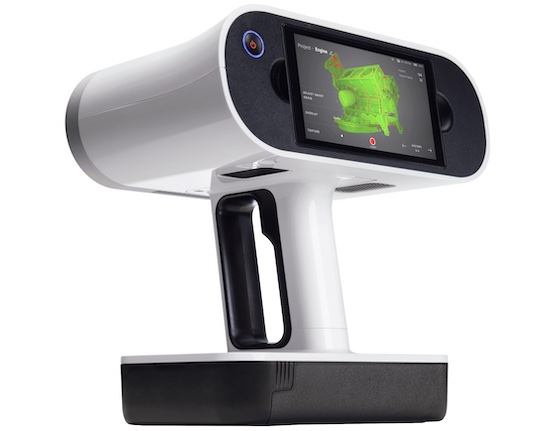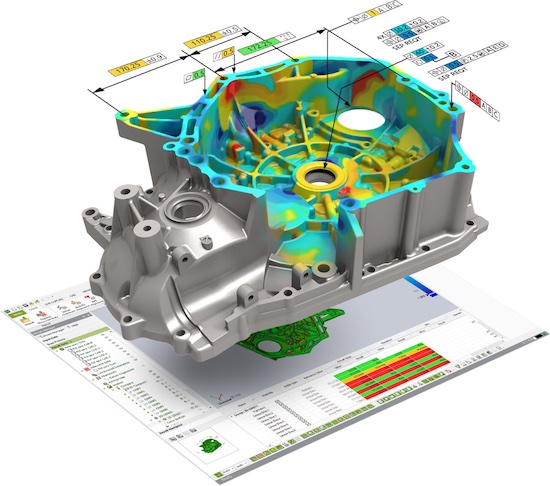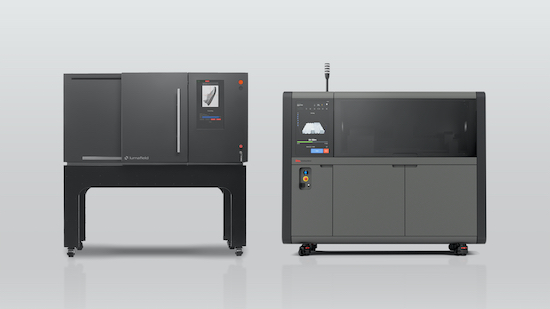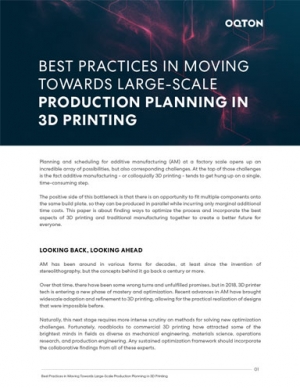Simplifying 3D Scan-to-Print Workflows
Lower cost offerings and AI-enabled automation help streamline scan-to-print workflows in light of more interest in reverse engineering and quality assurance use cases.

A wooden dragon was scanned and reverse engineered in Geomagic Design X, then additively manufactured and printed to match The Great Pagoda. Image courtesy of Oqton.
Latest News
October 27, 2022
3D scanning and 3D printing have come a long way over the last 10 years thanks to improvements in hardware and software. Though each category has gained traction in its own right, there are still challenges to harnessing both as part of an integrated workflow—a scenario being addressed by a wave of new technologies and offerings.
Interest in streamlined 3D scan-to-CAD-to-3D print workflows is on the rise, especially for reverse engineering and quality control applications. The years-long global pandemic and subsequent supply chain interruptions and logistics challenges have exacerbated manufacturers’ need to easily and cost-effectively reverse engineer parts that are either in short supply, no longer readily available from overseas suppliers or part of legacy inventory that lacks corresponding 3D CAD models and documentation.
“When machinery replacement parts became even harder to secure, reverse engineering allowed businesses to 3D print a stop-gap replacement through a scan-to-CAD-to-3D print process,” says Joe Johnson, a mechanical engineer at Formlabs. “This workflow reduces reliance on external suppliers for equipment, offering businesses the opportunity to supply themselves internally.”
Another factor that fuels interest in accessible scan-to-print scenarios is the push to digitally transform product design and manufacturing processes. As companies steer toward intelligent products and operations, there is a growing desire to create robust digital twins of parts and products—a requirement that benefits from smoother 3D scan-to-CAD-to-3D print integration.

Artec 3D’s Leo 3D scanner combines AI-driven automatic processing and wireless connectivity to simplify reverse engineering and quality inspection workflows. Image courtesy of Artec 3D.
“If you don’t have the 3D CAD data needed to create [a digital twin], you have to start from scratch, which could take weeks or months,” notes Thorsten Strauss, sales director for EMEA for the Geomagic software line at Oqton, now owned by 3D Systems. “With 3D scanning, you can handle the work in a short period of time. It’s all about time and cost savings along with greater flexibility.”
Gaps in the Workflow
Though the utility of smoother 3D scan-to-CAD-to-3D print workflows is evident, there are challenges on both ends of the spectrum that have slowed adoption and inhibited widespread use.
On the 3D scanning side, industrial-grade scanners have been price prohibitive for many companies and are sometimes hindered by an inability to capture all objects and surfaces, particularly those with shiny or transparent finishes. The process also creates copious amounts of data—3D meshes or point clouds comprising millions of vertices and polygons that are difficult to manipulate and often require extensive repair work to make them useful.
Most engineers are looking for a boundary representation (BREP) or CAD model of the item they want to scan, which is difficult to achieve without the proper set of tools; even with the right assets, the process still requires specific expertise and engineering know-how.
“Depending on what 3D scanner you use, some scans are noisier than others, but the noise is always present,” says Gleb Gusev, CTO of Artec 3D. “They can also be inaccurate or incomplete, which means that just like any digitization process, 3D scanning can introduce its own errors into the result.”
Not only can 3D scanning introduce errors, but the scanned object is often imprecise with flaws and inaccuracies. Gusev cautions that CAD models can also be ambiguous, requiring access to the original engineering design intent, which is not always available to guide reverse engineering or quality assurance workflows.

Geomagic Control X supports a workflow for capturing and inspecting real part scan data to analyze deviation and improve design and manufacturing processes. Image courtesy of Oqton.
There are subsequent hurdles associated with preparing 3D CAD models for 3D printing. CAD models are typically developed without any specific production technology in mind or adapted for a specific method at a later date. That means a 3D model that works well for an injection molding application might not hold up adequately for a Fused Deposition Modeling (FDM) or other AM process, Gusev says.
“In order to produce a print-ready model, it’s necessary to adapt it to the specific technology that will be used for manufacturing,” Gusev explains. “For some companies, that can be a very expensive process and there isn’t enough of an incentive for manufacturers to spend their resources on adapting all their CAD files for 3D printing.”
Solutions on the Way
3D scanner and 3D printer companies are stepping up to address many of these gaps. Artec 3D, for one, is using emerging technologies like AI and neural networks to automate some of the scanning process and ensure higher quality images. The company’s Artec Leo scanner introduces HD Mode, an AI-driven 3D reconstruction process designed to increase the resolution of the scanner by 2.5-fold and reduce the amount of noise in the scans dramatically—in particular, increasing sharpness and ensuring successful reconstruction of hard-to-reach areas, Gusev says.
The firm’s Artec Studio software has also been enhanced, including the ability to present scans as a set of primitives to be more easily imported into CAD software.
“We’ve added new measurements, freeform surface fitting, auto surfacing and datum alignment to help reverse engineer quite complex models,” he says.
Looking forward, the firm is experimenting with neural networks to automatically segment, plan out and perform reverse engineering of 3D scans.
Lumafield is tackling the scan-to-print accessibility challenge through use of AI and by democratizing a scanning approach based on X-ray computed tomography. The company’s Neptune scanner digitizes parts via X-ray images that capture external and internal features in detail while the Voyager cloud-based software creates a 3D model that can be easily exported as a mesh representation for 3D printing. The software also features an automated analysis engine that pinpoints voids, pores and cracks, taking the guesswork out of inspection, officials say.

Lumafield and Desktop Metal have partnered promoting their respective CT scanner and 3D printer for quick and accurate production of high-demand parts. Image courtesy of Desktop Metal.
Compared to traditional line of sight scanners, Neptune’s CT approach can capture all the detail from parts without human intervention; it also incorporates AI-powered configuration capabilities and a user-friendly touchscreen, which enables anyone to set it up with minimal training as opposed to legacy CT scanners, which typically require dedicated experts, explains Andrew Parrett, Lumafield’s product manager.
“We designed the scanner with a simple threshold—make it intuitive and user friendly to extract the mesh you want,” he explains.
Lumafield is also partnering with Desktop Metal to showcase the power of 3D scan-to-print workflows. The partners’ Supply Chain Resilience Package offers any company purchasing a Desktop Metal 3D printer and Lumafield CT scanner a package of CT scans and application engineering support as they await delivery of their Neptune scanner, slated to ship in the fourth quarter.
At Oqton, delivering an end-to-end workflow for 3D scan-to-print is what differentiates its offerings from individual standalone products, according to Strauss. Geomagic Design X reverse engineering, Geomagic Control X 3D inspection and metrology, and Geomagic Wrap 3D scanning software deliver a modular approach to 3D scan-to-print workflows, enabling engineering teams to assemble different functionalities that fit specific use cases at different price points.
“We don’t offer one product and say `take it or leave it’— we listen and know what people need,” Strauss says.
Oqton also works closely with 3D scanner and 3D printer manufacturers, including parent 3D Systems, to continuously develop and improve its product line, he adds.
Even with these advancements, the road to seamless 3D scan-to-CAD-to-3D print workflows is still some time away. But as more AI and user-friendly innovations are infused into product offerings, the promise for the future is more automated workflows, opening up a raft of new design and reverse engineering possibilities.
“Step by step, algorithms will be integrated into the process, which will allow us to build simpler solutions with cleaner interfaces that require less and less manual processing and input, Gusev says.
Beth Stackpole is a contributing editor to DE. You can reach her at [email protected].
More 3D Systems Coverage
More Artec 3D Coverage
More Formlabs Coverage
More Oqton Coverage

Subscribe to our FREE magazine, FREE email newsletters or both!
Latest News
About the Author
Beth Stackpole is a contributing editor to Digital Engineering. Send e-mail about this article to [email protected].
Follow DE






